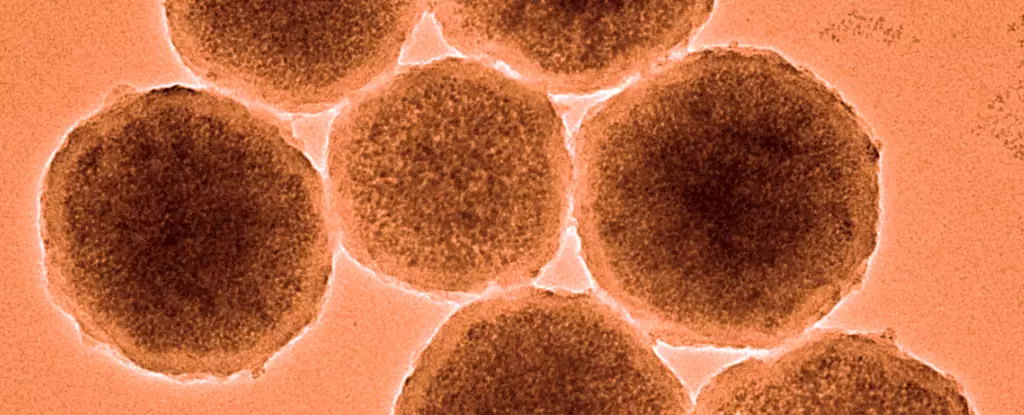

In the realm of medical advancements, the introduction of nanotechnology offers exceptional promise, with new innovations set to address critical health issues effectively. Research originating from an international collaboration between Shanghai Jiao Tong University and the University of Edinburgh suggests that miniature, spherical nanobots could become lifesavers for individuals suffering from brain aneurysms—a condition that could lead to severe health consequences, including death. With these tiny devices, experts envision a future where strokes caused by ruptured aneurysms are significantly reduced, potentially saving countless lives each year.
The proposed nanobots, measuring a mere 300 nanometers in diameter, are crafted from a magnetite core encapsulated in a specialized coating that only melts at a temperature slightly above the human body’s. This precise design enables the devices to navigate through the intricate maze of blood vessels, delivering targeted doses of clotting agents—specifically thrombin—when they reach their destination. Utilizing a magnetic field allows skilled technicians to maneuver these bots through the blood vessels and apply heat to melt their protective shell, thus releasing their crucial payload to initiate the clotting process necessary for preventing aneurysm rupture.
The ability of these nanobots to deliver medication with pinpoint accuracy stands in stark contrast to traditional methods of treatment, which often carry higher risks. Conventional approaches, such as surgical clipping or endovascular coiling, come with the likelihood of complications and potential rejection of medical implants. The advent of nanobots may eliminate these challenges, providing a minimally invasive solution to a complex medical issue.
Initial trials employing these nanobots yielded promising results. The research team conducted experiments that demonstrated the efficacy of the nanotechnology, confirming its capability to clot effectively while also assessing its safety profile. The absence of inflammation or collateral damage during drug delivery marks a significant milestone in the research and development of nanomedicine. Such findings indicate that, as the technology advances, it could soon transition from experimental to clinical settings, offering hope to stroke-prone patients.
However, despite these encouraging outcomes, the journey towards integrating nanobots into standard medical practice is not without challenges. Researchers must refine the bots’ navigation systems to ensure they can reach deeper, hard-to-access areas of the human body beyond the current magnetic capabilities. This step will be critical in proving the technology’s versatility and effectiveness in various medical scenarios.
Globally, brain aneurysms affect an estimated 3% of the population, and though only a fraction may rupture, the implications of such events are dire. Ischemic strokes caused by ruptured aneurysms can lead to life-long disabilities or fatal outcomes. Historically, medical professionals have relied on surgical techniques to manage these risks; however, the introduction of nanobots could revolutionize preventive measures and lessen dependence on invasive interventions.
By adopting a more direct approach to treating affected areas within the body, nanobots could serve as a transformative tool for neurosurgeons, allowing them to mitigate risks while improving patient outcomes. This innovation not only has implications for brain health but may also extend to other medical fields, highlighting the adaptable potential of nanotechnology across various disciplines.
The burgeoning field of nanotechnology encapsulates innovative possibilities for treating life-threatening conditions, representing a new frontier in medicine. The development of nanobots designed to prevent aneurysms from rupturing demonstrates a significant leap forward in enhancing patient safety and expediting care in emergency situations.
As researchers continue to refine these technologies and prepare for clinical trials, the vision of a future where nanobots serve as microscopic paramedics within the human body moves closer to reality. Should these promising developments materialize fully, they hold the potential not simply to change treatment paradigms but to foster a new era of precision medicine that acts swiftly and effectively in crisis situations, truly revolutionizing how we approach serious health challenges.
In the realm of software development, the ability to swiftly and accurately address bugs is…
The realm of quantum computing and communication is not just an abstract dream anymore; it…
In a remarkable leap for the field of material science, a collaborative research initiative has…
Throughout Earth's vast history, our planet has endured five major mass extinction events that reshaped…
Rainfall is a vital element of our planet’s hydrological cycle, yet many aspects of its…
On a night when the universe aligns, a mesmerizing phenomenon awaits: the appearance of the…
This website uses cookies.